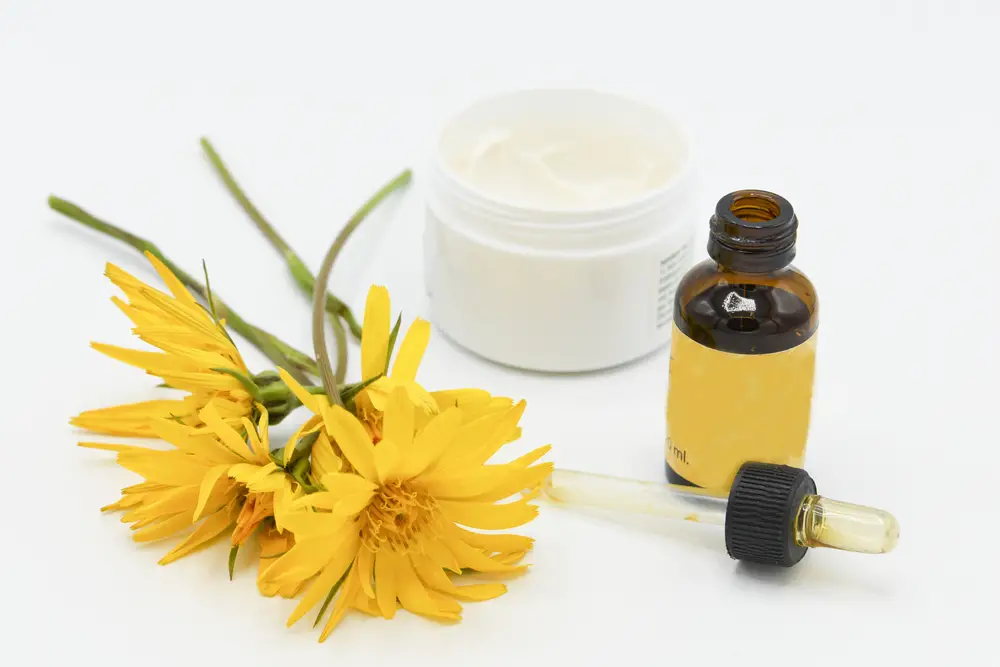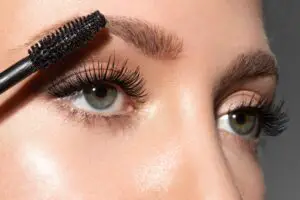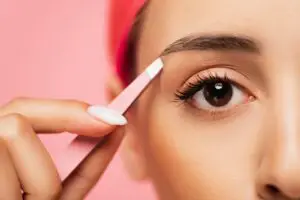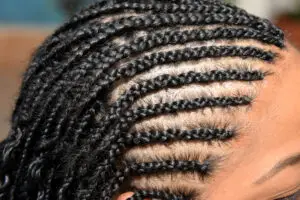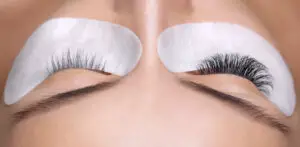Arnica montana, commonly known as arnica, is a natural herb that belongs to the Asteraceae family. This herb is native to the subalpine regions of Western North America and can also be found in the Arctic. The arnica plant is renowned for its vibrant, daisy-like flowers and long, downy leaves.
As a popular remedy in homeopathic medicine, arnica cream has been used for centuries to treat various ailments. The topical application of arnica cream is considered safe when applied in a thin layer to unbroken skin. Its primary uses include the treatment of muscle pain (myalgia), joint pain (arthralgia), inflammation, and bruising. The herb’s properties help alleviate discomfort and promote natural healing.
However, it must be noted that arnica contains a toxin called helenalin, which can be deadly if consumed in large quantities. Therefore, arnica preparations should be used cautiously and exclusively as a topical treatment or heavily diluted as homeopathic tablets or sprays.
What is Arnica Cream
Arnica cream is a popular homeopathic remedy made from the extract of the Arnica montana plant. It is commonly available in various forms, such as creams, gels, ointments, and tinctures. The primary use of arnica cream is to provide relief from aches, pains, and bruises1.
Known for its anti-inflammatory and pain-relieving properties, arnica cream is widely used to alleviate muscle pain (myalgia), joint pain (arthralgia), inflammation, and bruising2. It is generally considered safe when applied topically in a thin layer on unbroken skin3. Additionally, arnica can be found in homeopathic tablets or sprays, which contain heavily diluted arnica for oral consumption4.
Here are some common applications of arnica cream:
- Bruises: Arnica cream can assist in reducing the appearance of bruises, as well as alleviating the pain and discomfort.
- Muscle aches: Physical activity may lead to muscle soreness and aches; using arnica cream on the affected area may alleviate the discomfort.
- Joint pain: Individuals suffering from joint pain, such as arthritis, may find relief by applying arnica cream onto the affected area.
- Inflammation: Arnica’s anti-inflammatory properties make it a suitable topical remedy for reducing inflammation due to injuries or medical conditions.
To use arnica cream, apply a thin layer to the affected area, ensuring the skin is unbroken. Do not use arnica cream on open wounds or broken skin, as it may cause irritation or adverse reactions. Arnica cream has a low risk of side effects and most people can safely use it for various symptoms5. However, if you experience any adverse reactions, discontinue use and consult a healthcare professional.
Main Uses of Arnica Cream
Bruising and Swelling
Arnica cream is commonly utilised for reducing bruising and swelling caused by injuries. This natural ointment contains anti-inflammatory properties that help alleviate inflammation and promote the healing process. Arnica is particularly beneficial for treating bruises, as it encourages the body’s natural healing response and supports the clearing of pooled blood.
Pain Relief
Another key use of Arnica cream is its effectiveness in providing relief from various types of pain. The herb’s analgesic properties help to alleviate muscle pain and discomfort associated with sprains and strains. Topical application of Arnica cream can help individuals manage aches and discomfort by reducing inflammation and promoting overall muscle relaxation.
Arthritis and Joint Pain
Individuals suffering from arthritis and joint pain may also benefit from using Arnica cream. The anti-inflammatory characteristics of Arnica contribute to reducing joint inflammation and swelling, which are commonly experienced in conditions such as arthritis. By soothing joints and alleviating pain, Arnica cream can improve the quality of life for those living with chronic joint conditions.
Eczema
While less known for this use, Arnica cream can also be helpful in addressing skin conditions such as eczema. The herb’s anti-inflammatory properties can assist in soothing inflamed and irritated skin, offering relief from itchiness and discomfort. However, it is crucial to consult a healthcare professional before using Arnica cream for eczema, as it may not be suitable for all individuals or skin types.
Safety and Precautions
General Safety
Arnica cream is considered safe when applied topically in a thin layer on unbroken skin. However, some individuals may experience an allergic reaction, such as redness, itching, or irritation. It is essential to avoid applying arnica cream on broken skin, in the eyes, or near mucous membranes, as this may lead to further complications. People who are allergic to daisies or chrysanthemums should also exercise caution, as they may have a higher likelihood of sensitivity to arnica.
It is worth noting that arnica can be poisonous when consumed in large amounts, potentially causing side effects like rapid heartbeat or bleeding. Therefore, it should not be ingested unless it is in a heavily diluted, homeopathic form.
Use During Pregnancy
Pregnant and breastfeeding women should exercise caution when using arnica cream. There is limited information on the safety of arnica during pregnancy, and some sources suggest it may not be safe for use. Pregnant and breastfeeding women should consult their healthcare provider before incorporating arnica cream into their routine.
Use in Children
Arnica cream is typically safe for use in children, provided it is applied to unbroken skin. However, the appropriate dosage and frequency may differ from adults, so it is important to consult with a healthcare professional before using arnica cream on young ones. In all cases, ensure that children do not accidentally ingest arnica cream, as it can be toxic in large quantities.
Possible Interactions and Side Effects
Arnica cream is a herbal remedy primarily used for relieving pain, inflammation, and bruising. Nevertheless, it is crucial to be aware of some potential interactions with medications and dietary supplements and possible side effects to ensure safe usage.
Medical Interactions
Using arnica cream alongside certain medications can lead to unwanted interactions. For instance, when applied together with anti-inflammatory drugs like ibuprofen and other nonsteroidal anti-inflammatory drugs (NSAIDs), arnica cream’s effects may be compromised, resulting in reduced efficacy. Additionally, anticoagulants, such as warfarin, may interact with arnica, which might pose a risk of increased bleeding. Therefore, it is essential to consult a healthcare professional before using arnica cream with these medications.
Dietary and Supplement Interactions
Herbal supplements, such as echinacea and ginger, can also interact with arnica. These herbs are known for their anti-inflammatory properties, similar to arnica, which may lead to redundancies or other unwanted effects if used together. Care should be taken when combining arnica with other natural supplements, and it’s recommended to seek professional guidance for proper dosing and usage.
Arnica cream might cause several side effects in some individuals, including allergic reactions or skin irritation. Ingesting large amounts of arnica can lead to more severe side effects, such as nausea, vomiting, diarrhoea, muscle weakness, and heart irregularities1. It’s vital to follow the appropriate dosing guidelines and be cautious about contraindications to prevent these complications.
In conclusion, it is essential to be aware of possible interactions and side effects when using arnica. By acknowledging these factors and following proper precautions, individuals can use arnica cream safely for pain relief and other therapeutic purposes.
Application and Dosage Instructions
Arnica cream is a popular topical treatment derived from the Arnica montana flower, traditionally used for soothing bruises, sprains, and muscle pain. Available in various forms such as gels, creams, and ointments, arnica is applied directly to the affected area for its therapeutic effects.
When using arnica cream, it’s crucial to follow the appropriate dosage instructions. In general, a thin layer of the product should be gently applied to the affected area, covering it entirely. Ensure that the skin is clean and dry before application to maximise absorption. The cream can be applied up to four times a day, depending on the severity of the condition and the product guidelines.
It’s essential to pay attention to the specific ingredients in the arnica cream chosen as different formulations may contain varying concentrations of the active substance. Additionally, there may be added ingredients for specific purposes, such as skin conditioning or added pain relief. Be mindful of potential allergies or sensitivities to certain components and consult a healthcare professional if any adverse reactions occur.
As with any topical treatment, some caution is necessary when using arnica cream. Avoid applying the product to open wounds or broken skin to prevent potential irritation or adverse reactions. It is also not recommended for use during pregnancy or breastfeeding, as the safety profile is not well established in these situations.
In conclusion, arnica cream can be a helpful addition to the management of bruises, sprains, and muscle pain when applied correctly. Pay attention to the product’s specific ingredients, follow the recommended dosage instructions, and exercise caution to ensure safe and effective use.
Scientific Evidence and Effectiveness
Arnica cream is a popular natural remedy that has been used for centuries to treat various ailments like contusions, wounds, rheumatism, and inflammation1. In recent years, there has been an increasing interest in this natural remedy, with various clinical trials and research studies conducted to evaluate its effectiveness in relieving pain and speeding up recovery.
One particular focus of these studies is the use of Arnica cream in managing muscle pain. For instance, a study on topical Arnica for muscle pain found that pain scores on legs treated with Arnica were higher than those receiving placebo 24 hours after exercise3. While the evidence from this study suggests Arnica’s potential in managing muscle pain, it is essential to consider the opinions of experts and healthcare providers.
Another systematic review of placebo-controlled clinical trials evaluated the efficacy of homeopathic Arnica montana5. Although Arnica montana is frequently studied, the review found inconclusive results, and the treatment’s clinical efficacy remains controversial. It is crucial to consult a doctor or pharmacist before using any natural remedy, including Arnica cream, to obtain reliable advice on its effectiveness and possible side effects.
In addition to its potential pain-relieving properties, Arnica is said to have anti-inflammatory qualities, which might help alleviate joint and muscle pain2. However, it is important to use this remedy with caution, as improper usage might lead to potential side effects or unexpected outcomes. It is highly recommended to follow the guidance of a healthcare provider or a reliable source with extensive knowledge about Arnica to ensure its safe and effective use.
In conclusion, the current scientific evidence on Arnica cream’s effectiveness is not without its controversies. While some studies suggest its potential in managing pain, others yield inconclusive results. To fully understand the benefits and potential risks of using Arnica cream, it is necessary to engage the expertise of healthcare providers, doctors, and pharmacists to make informed decisions about its use.

I’m Jennifer a beauty and wellness expert. I believe in promoting a sustainable and healthy lifestyle from within. Helping people feel good is my passion; whether it’s teaching yoga or offering skincare advice.

